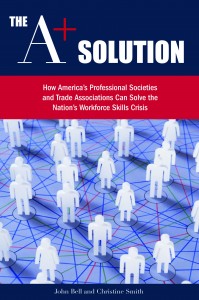Features
Filling the Workforce Skills Gap
 The final day of education at the ASAE 2014 Annual Meeting started off at the session based on the book, “The A+ Solution” by John Bell and Christine Smith of Boxwood. Entitled “How Your Association Can Help Solve the Nation’s Workforce Skills Gap,” the session was designed with an expert panel that offered varied experiences with ways they’ve increased association visibility as continuing education providers.
The final day of education at the ASAE 2014 Annual Meeting started off at the session based on the book, “The A+ Solution” by John Bell and Christine Smith of Boxwood. Entitled “How Your Association Can Help Solve the Nation’s Workforce Skills Gap,” the session was designed with an expert panel that offered varied experiences with ways they’ve increased association visibility as continuing education providers.The panel included:
Patrick Gouhin, executive director and CEO of the International Society of Automation
Annette Homan, deputy executive director of the Risk and Insurance Management Society
Terri Gaffney, senior director of new product development at the American Nurses Association
Eric Berkowitz, membership director of the IEEE Computer Society
The skills gap is a disparity that exists between employers looking for skilled workers and job seekers who lack the right skills. While government legislation has been passed for decades to try to fix this issue, the gap still remains.

Smith says that associations are in a unique position to help job seekers develop the skills they need, but first they have to come to the table and join the national discussion on the topic. Traditionally much of the funding goes to community colleges and trade shows, but associations should also be considered as sources of training, she said.
Going down the panel of experts, each group had a slightly different program they had established to drive increased membership to their associations through improved visibility, and showcase their certification and learning tools.
Gouhin shared that ISA has chosen to try to meet their industry’s needs in a variety of ways including education and training through hands-on training sessions with expert instructors provided to members, a certification program, education and conferences and through published tools like books, a magazine and technical journal and by setting industry standards for excellence.
For Homan at RIMS, the goal was to help members to be sustainable into the future. “We took what they needed and acted upon it,” she said. RIMS offers educational resources like white papers, webinars, a knowledge repository, and education sessions at their conference. They also offer a designation program, with the goal of helping to give members an edge over their competitors.
At the ANA, the shortage of experienced nurses and the inability for new nurses to get positions just out of college led to the development of a “Welcome to the profession” tool kit. Meanwhile at IEEE SWEBOK certifications alongside tradition training offerings and knowledge centers available to members help to raise the skill level of members to match the expectations of hiring managers.
Through audience participation in the session it was clear that many associations were dealing with issues in supporting their industries — especially trade industries — in educating job seekers to fill the jobs available in the marketplace. It was also clear that there are many different fragmented efforts to find a solution to the skills gap issue.
Just through audience comments, several different programs were mentioned that were unknown to the rest of the group.
Smith reiterated that those disconnects are the perfect example of why associations need to be a part of the national dialogue on this issue. At the end of the session many participants shared their contact information to be part of a larger, continuing conversation about the skills gap.
Is your industry being affected by the workforce skills gap? What is your association doing to help make sure your members are prepared to lead in the marketplace and support your industry?

